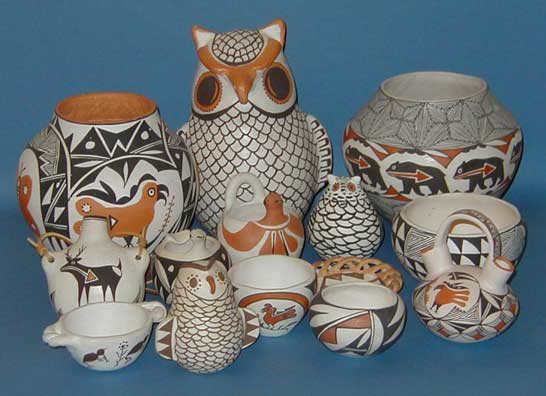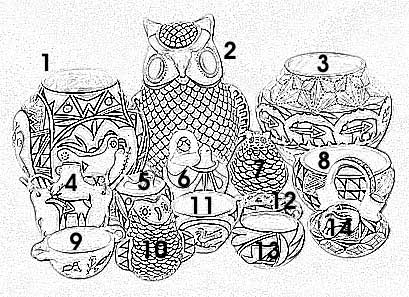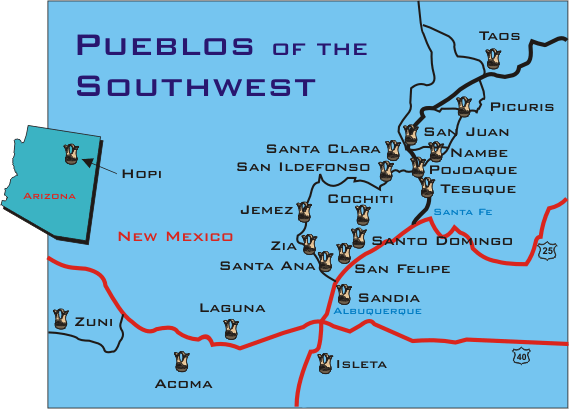 ClayHound
Web -
Acoma Pueblo
ClayHound
Web -
Acoma PuebloReturn to:
|
Acoma Pueblo Pottery |
|
|
|
|
|
|
|
|
|
|
Acoma Pueblo is located in west-central New Mexico and is also named "Sky City". It's local clay is of such a consistency that it allows for very thin walls. The pottery is often characterized by the bright white slip. Prior to 1700 Acoma Pueblo was noted for its magnificent glazed ware with convex jar bases. After the Pueblo Indian revolt of 1680, this pueblo turned from the creation of magnificent glaze wares to matte-paint wares, and the concave base became a standard feature for Acoma water jars. It should be noted that Acoma potters have traditionally tempered their clay with finely crushed sherds of pottery, so that nearly every broken vessel is saved for re-use in this manner. This is a distinctive feature of Acoma, Laguna, and Zuni pottery, affording a strong contrast with wares from the other pueblos. The vessels made today by Acoma potters may well contain fragments of Prehistoric glaze ware, some of the occurring for perhaps the second for third time in an Acoma vessel. |
|
|
Known as "Sky City," the Pueblo of Acoma is situated on a 367-foot-high sandstone rock. It is considered to be the oldest inhabited village in the United States. Acoma was nearly destroyed when Governor Juan de Oņate and 70 of his men retaliated for the killing of 13 Spanish soldiers by the Acomas when they tried to steal grain from the pueblo storehouses in 1598. As a restitution of peace, the San Esteban del Rey Mission was built in 1629 and completed in 1640 under the guidance of Friar Juan Ramirez.
In the legends of the Acoma (OCK-o-ma)
peoples, a story is told of the sacred twins leading their ancestors
to Ako, the magical white rock which became their permanent home. The
twins also discovered and shared with their people, the whitest,
finest clay in all the Southwest. Sky City, the old pueblo of Acoma
claims to be the oldest continuously occupied settlement in the United
States. They may, however, get an argument from the Hopi peoples of
Old Oraibi village who also claim this distinction. |
|
|
Thin-walled, large ollas, slipped in pure white and decorated in red and black set the standard for Acoma fine pottery ever since the 18th-century. But that hardly begins to describe the intricate and dramatic designs which characterize modern Acoma pottery. In 1880, the railroad caused a major change in the pottery market. Traders and tourists were unable to travel with the larger ollas, so potters turned to making smaller, eccentric, more manageable pieces. During the 1970's and 1980's, new methods threatened to bury the old pottery traditions at Acoma. Kiln-firing became the rage and the economics of greenware drew more and more potters. But the incentives that enticed potters to use these methods are slowly disappearing. More potters are turning away from it in favor of more traditional pieces. Acoma pottery has ended the century on a high note. The best potters approach their craft with a competitiveness that pushes their standards ever higher from - http://www.geocities.com/earthwalkcreations/Hist_Acoma.html |
|






